Browse By Unit
How Can I Be Prepared for the AP French Multiple Choice?
5 min read•july 11, 2024
Charly Castillo
Charly Castillo
AP French Multiple Choice Help (MCQ)
Even though we may not focus on it as much, understanding the format of an AP exam is just as important as being well-versed in the class content 📚 Knowing the answer to questions like "How long is the multiple-choice section?" and "What type of questions will I be given in free-response?" helps you avoid surprises on testing day. That way, you can pace yourself throughout, know all the material that is addressed, and most importantly, feel confident in how you did 😄
In this post, we'll be going over everything you need to know multiple choice section of the AP French exam 📝 before test day, from what they look like to what they'll be on. Let's get into it!
MCQ Format & Timing
When you start the exam on test day, the first part that you'll be completing is the multiple-choice section, which is sometimes referred to by the acronym MCQs.
On the AP French exam, this section is made up of 65 questions, 30 that don't have audio and 35 that do. You'll be given 40 minutes to answer the questions without audio and 55 minutes for ones with it, which means you have 1 hour and 35 minutes in total to finish the section. By doing some quick calculations, you can figure out that, ideally, you should spend around 1.3 minutes or less on each question without audio and less than 1.6 minutes for the audio questions, and this includes reading/listening time. Whew, that was too much math 😅.
You might be wondering why all of that math above ⬆️ was important, but it's actually really helpful to know when learning to pace yourself and trying to get a feel for the test. And since this section is worth 50% of your final AP score, it's good to know the ins and outs of it.
Here's a summary of everything we just reviewed about the sections above, the multiple-choice and the multiple-choice with audio:
Section 1A: Multiple Choice ⚪⚪⚪⚫
- 30 questions based on written materials like advertisements, chart, and literary texts
- 40 minutes to complete
Section 1B: Multiple Choice with Audio ⚪⚪⚪⚫ 🔊
- 35 questions based on both literary and audio sources like conversations, presentations, and public service announcements
- 5 sets total: 2 are a combination of audio and written sources, 3 are just audio
- 55 minutes to complete
MCQ Topics
As you probably already know, the questions on the exam align to the material covered in the AP French course. This means that each source you read or hear will somehow be related to at least one of the class' units. If you don't know what they are, they're listed below:
- Unit 1: Families in Different Societies 👨👩👧👦 👨👦 👩👩👧
- Unit 2: The Influence of Language and Culture on Identity 🎼
- Unit 3: Influences of Beauty and Art 🎭
- Unit 4: How Science and Technology Affect Our Lives 🤖
- Unit 5: Factors That Impact the Quality of Life 🏚️
- Unit 6: Environmental, Political, and Societal Challenges 🌪️
Example MCQs
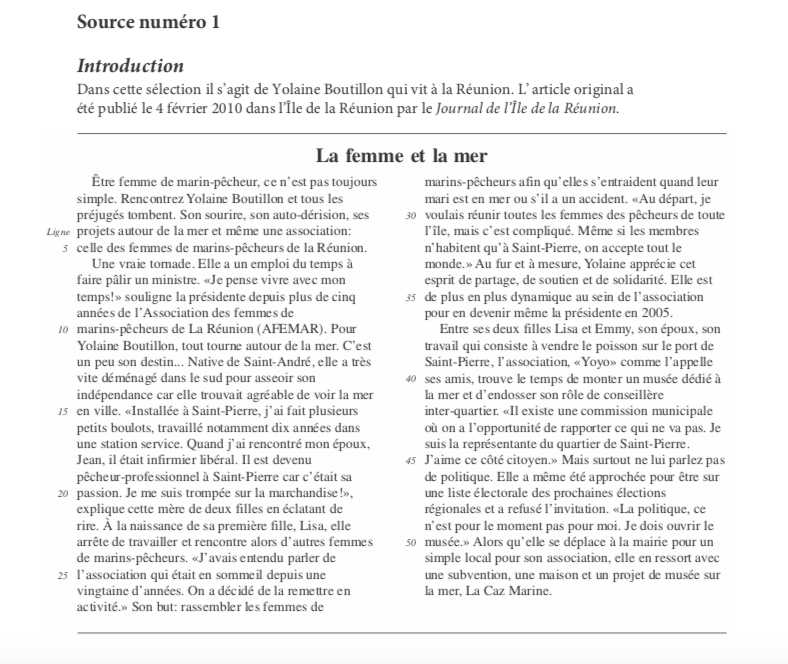
Image from the 2011 AP French Language and Culture CED. Example of a source you may see on the exam
So, now that you have an understanding of what type of written sources are on the AP French exam, let's get into some practice multiple choice that you can try.
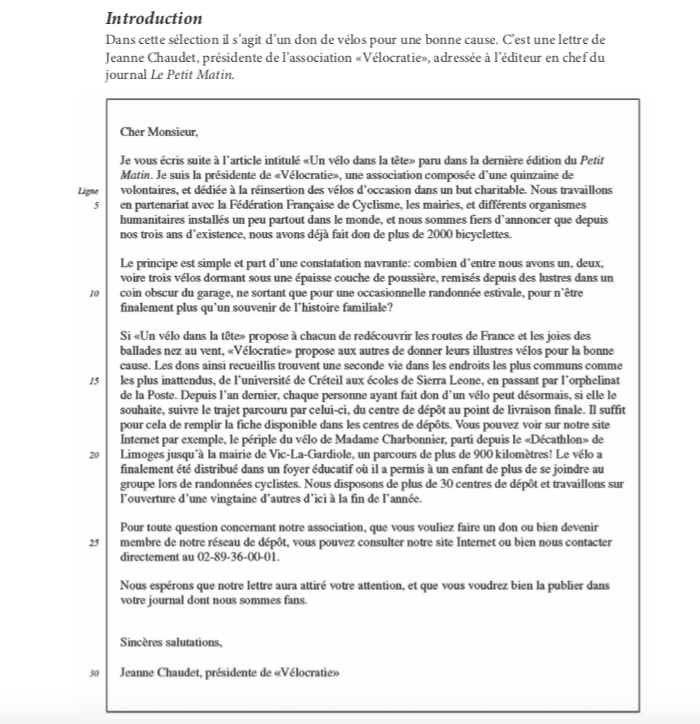
Image from the 2011 AP French Language and Culture CED. Example of a source you may see on the exam. Be sure to read through it before trying the example problems below!
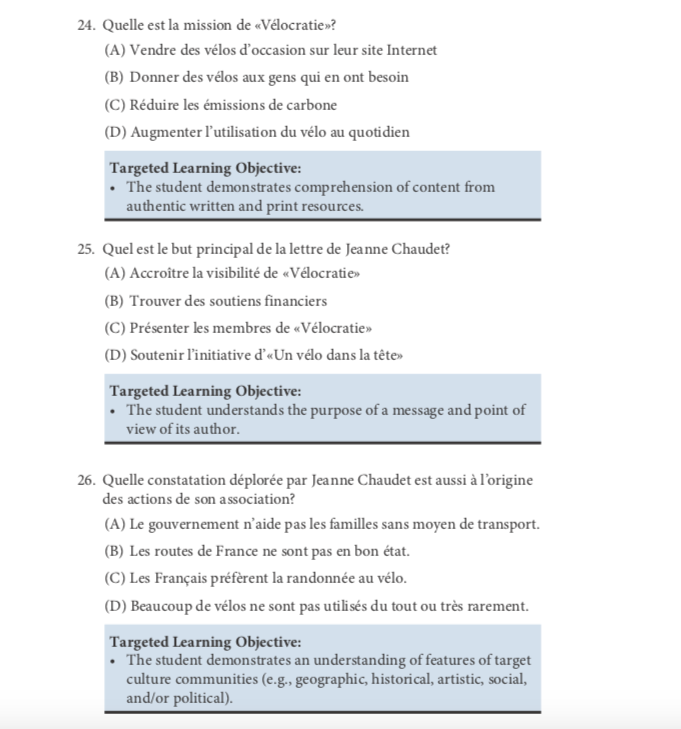
Image from the 2011 AP French Language and Culture CED. Example of multiple choice questions
The first question is asking "Quelle est la mission de «Vélocratie»?", which means "What is Vélocratie's mission?". After reading the excerpt, you should know that the association gives bikes to those who are in need of one, which means that (B) donner des vélos aux gens qui en ont besoin 🚴♀️ is the best choice.
Question 2 uses a phrase that all AP French students should be familiar with by the end of the course, "le but principal", which means the main purpose. So, the objective that Jeanne Chaudet had in writing this letter ✉️ was to make more people aware of «Vélocratie», which means that (A) accroître la visibilité de «Vélocratie» is the answer.
Last question for this print source! It may be a bit wordier than the two previous ones, but don't let this trip you up; just be sure to read through it well and find the option that best fits the question asked. In this case, it's (D) beaucoup de vélos ne sont pas utilisés du tout 🚳 ou très rarement.
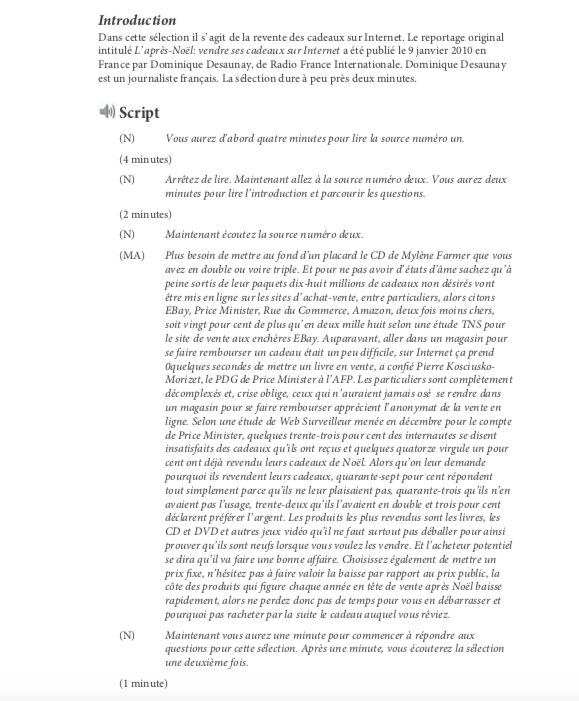
Image from the 2011 AP French Language and Culture CED. Example of a source you may see on the exam. Be sure to read through it before trying the example problems below!
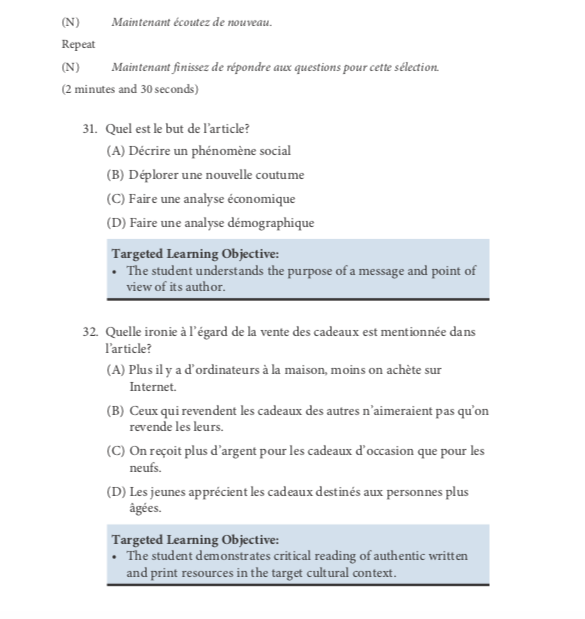
Image from the 2011 AP French Language and Culture CED. Example of multiple choice questions
And now on to a slightly shorter example. Question 1 has that key phrase that we mentioned earlier, which means that you should be looking for "le but principal" or the main purpose of the script above ⬆️ After reading through it, you should get (A) décrire un phénomène sociale as an answer, which means that it is describing a social phenomenon.
Last question! This one is asking for something ironic that is mentioned in the article about the sale of gifts 🎁 The speaker above mentions that those who resell other people's gifts would prefer if the ones they give were not resold, which means that (B) is the best fitting option.
And that's everything you need to know about the multiple-choice section! Hopefully, this post made you feel more comfortable with the content tested in this part and its structure. Whether you feel like you have this section in the bag or need more help with it, be sure to practice lots of multiple-choice questions before exam day in May. Happy studying, and bonne chance 🇫🇷
<< Hide Menu
How Can I Be Prepared for the AP French Multiple Choice?
5 min read•july 11, 2024
Charly Castillo
Charly Castillo
AP French Multiple Choice Help (MCQ)
Even though we may not focus on it as much, understanding the format of an AP exam is just as important as being well-versed in the class content 📚 Knowing the answer to questions like "How long is the multiple-choice section?" and "What type of questions will I be given in free-response?" helps you avoid surprises on testing day. That way, you can pace yourself throughout, know all the material that is addressed, and most importantly, feel confident in how you did 😄
In this post, we'll be going over everything you need to know multiple choice section of the AP French exam 📝 before test day, from what they look like to what they'll be on. Let's get into it!
MCQ Format & Timing
When you start the exam on test day, the first part that you'll be completing is the multiple-choice section, which is sometimes referred to by the acronym MCQs.
On the AP French exam, this section is made up of 65 questions, 30 that don't have audio and 35 that do. You'll be given 40 minutes to answer the questions without audio and 55 minutes for ones with it, which means you have 1 hour and 35 minutes in total to finish the section. By doing some quick calculations, you can figure out that, ideally, you should spend around 1.3 minutes or less on each question without audio and less than 1.6 minutes for the audio questions, and this includes reading/listening time. Whew, that was too much math 😅.
You might be wondering why all of that math above ⬆️ was important, but it's actually really helpful to know when learning to pace yourself and trying to get a feel for the test. And since this section is worth 50% of your final AP score, it's good to know the ins and outs of it.
Here's a summary of everything we just reviewed about the sections above, the multiple-choice and the multiple-choice with audio:
Section 1A: Multiple Choice ⚪⚪⚪⚫
- 30 questions based on written materials like advertisements, chart, and literary texts
- 40 minutes to complete
Section 1B: Multiple Choice with Audio ⚪⚪⚪⚫ 🔊
- 35 questions based on both literary and audio sources like conversations, presentations, and public service announcements
- 5 sets total: 2 are a combination of audio and written sources, 3 are just audio
- 55 minutes to complete
MCQ Topics
As you probably already know, the questions on the exam align to the material covered in the AP French course. This means that each source you read or hear will somehow be related to at least one of the class' units. If you don't know what they are, they're listed below:
- Unit 1: Families in Different Societies 👨👩👧👦 👨👦 👩👩👧
- Unit 2: The Influence of Language and Culture on Identity 🎼
- Unit 3: Influences of Beauty and Art 🎭
- Unit 4: How Science and Technology Affect Our Lives 🤖
- Unit 5: Factors That Impact the Quality of Life 🏚️
- Unit 6: Environmental, Political, and Societal Challenges 🌪️
Example MCQs

Image from the 2011 AP French Language and Culture CED. Example of a source you may see on the exam
So, now that you have an understanding of what type of written sources are on the AP French exam, let's get into some practice multiple choice that you can try.

Image from the 2011 AP French Language and Culture CED. Example of a source you may see on the exam. Be sure to read through it before trying the example problems below!

Image from the 2011 AP French Language and Culture CED. Example of multiple choice questions
The first question is asking "Quelle est la mission de «Vélocratie»?", which means "What is Vélocratie's mission?". After reading the excerpt, you should know that the association gives bikes to those who are in need of one, which means that (B) donner des vélos aux gens qui en ont besoin 🚴♀️ is the best choice.
Question 2 uses a phrase that all AP French students should be familiar with by the end of the course, "le but principal", which means the main purpose. So, the objective that Jeanne Chaudet had in writing this letter ✉️ was to make more people aware of «Vélocratie», which means that (A) accroître la visibilité de «Vélocratie» is the answer.
Last question for this print source! It may be a bit wordier than the two previous ones, but don't let this trip you up; just be sure to read through it well and find the option that best fits the question asked. In this case, it's (D) beaucoup de vélos ne sont pas utilisés du tout 🚳 ou très rarement.

Image from the 2011 AP French Language and Culture CED. Example of a source you may see on the exam. Be sure to read through it before trying the example problems below!

Image from the 2011 AP French Language and Culture CED. Example of multiple choice questions
And now on to a slightly shorter example. Question 1 has that key phrase that we mentioned earlier, which means that you should be looking for "le but principal" or the main purpose of the script above ⬆️ After reading through it, you should get (A) décrire un phénomène sociale as an answer, which means that it is describing a social phenomenon.
Last question! This one is asking for something ironic that is mentioned in the article about the sale of gifts 🎁 The speaker above mentions that those who resell other people's gifts would prefer if the ones they give were not resold, which means that (B) is the best fitting option.
And that's everything you need to know about the multiple-choice section! Hopefully, this post made you feel more comfortable with the content tested in this part and its structure. Whether you feel like you have this section in the bag or need more help with it, be sure to practice lots of multiple-choice questions before exam day in May. Happy studying, and bonne chance 🇫🇷

© 2025 Fiveable Inc. All rights reserved.